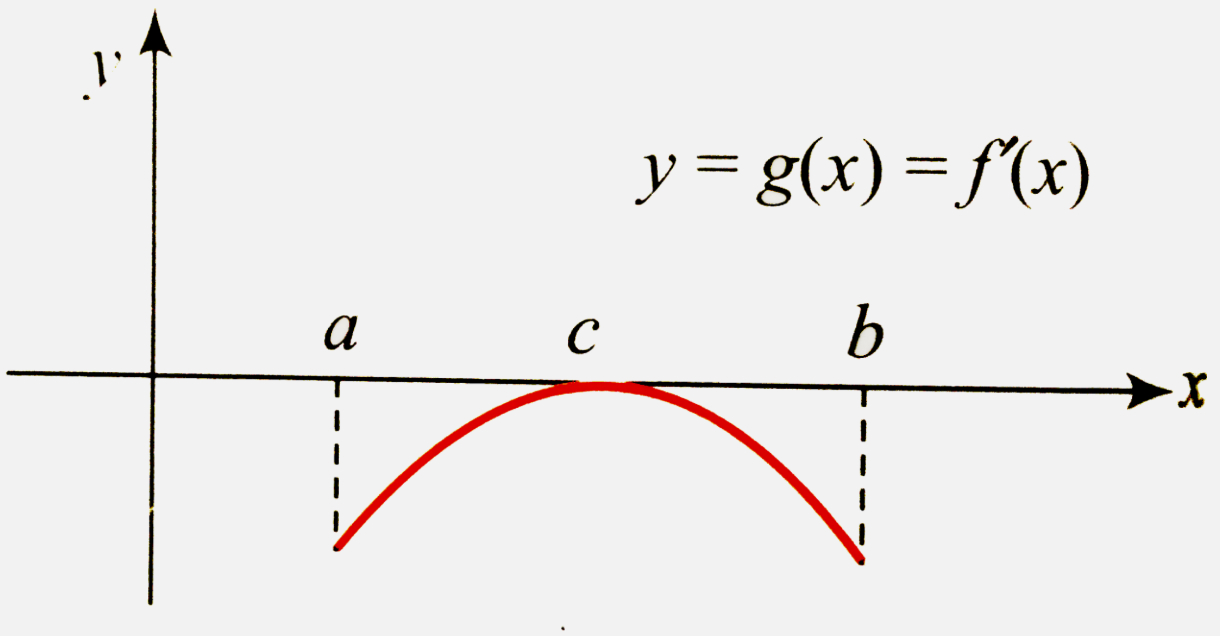Following is the graph of y = f' (x) , given that f(c) = 0. Analyse the graph and answer the following questions.
(a) How many times the graph of y = f(x) will intersect the x - axis?
(b) Discuss the type of roots of the equation f (x) = 0, a≤x≤b.
(c) How many points of inflection the graph of y=f(x),a≤x≤b, has?
(d) Find the points of local maxima/minima ofy=f(x),a<xb.
(e) How many roots equation f''(x)=0 has?

Text Solution
(a) f'(x)≤0,∀x∈[a,b], so f(x) is a decreasing function and f(c)=0⇒f(x) is a decreasing function and x(c)=0⇒f(x) cuts x - axis once when x = c.
(b) We note that f(c) = 0, f'(c) = 0. Also tangent to f'(x) at x = c is y = 0. So f''(c) = 0 Therefore, x = c is repeated root of third order. So the equation f(x) = 0 has at least three repeated roots.
(c) We have f''(c) = 0 . So the graph of y = f (x) has one point of inflection at x = c.
(d) As f (x) is a decreasing function for all x∈(a,b),f(x) has no local maxima or minima.
(e) f''(c)=0⇒c is a root of f''(x) = 0.
|
Topper's Solved these Questions
- GETTING STARTED WITH GRAPHSBOOK - CENGAGECHAPTER - GETTING STARTED WITH GRAPHSEXERCISE - Exercise
18 Videos
- FUNCTIONSBOOK - CENGAGECHAPTER - FUNCTIONSEXERCISE - Question Bank
30 Videos
- GRAPH OF INVERSE TRIGONOMETRIC FUNCTIONSBOOK - CENGAGECHAPTER - GRAPH OF INVERSE TRIGONOMETRIC FUNCTIONSEXERCISE - Exercise
18 Videos
Similar Questions
Knowledge Check
How many times does the graph of y=x3−3x2−x+3 intersects the x - axis :
A1B2C3Dnone of theseHow many times does the graph of y=x3−3x2−x+3 intersects the x - axis :
A1B2C3Dnone of theseHow many zeroes and there of y = f(x) for the given graph?
 A0B1C2D3
A0B1C2D3
Graph of y=f(x) is given, then
View SolutionIn how many points graph of y=x3−3x2+5x−3 intersect the x-axis?
View SolutionThe graph of y =g(x) =f(X) is as shown in the following figure analyse this graph and answer the following question

Number of points of inflectionn the graph of y = f(x) for a<x<b has
View SolutionThe graph of y=f(x) is given below

then the graph y=|f(|x|)| is :
View SolutionThe graph of y=f(x) is given below

then the graph y=|f(|x|)| is :
View Solution


